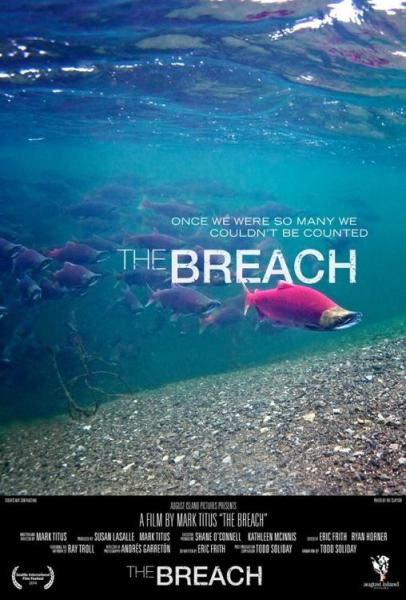
By Melissa Copeland
“The Breach” is an enticing documentary by a Washington filmmaker, Mark Titus.
This film goes in depth on the dwindling salmon populations and the efforts to help raise those populations.
Where have the wild salmon gone? How can we bring them back to native waters? These are two essential questions throughout the film.
Titus is the founder of August Island Pictures. Titus spent time at the University of Oregon and the Vancouver Film school learning to act and direct. During his 20’s, Titus spent time as an Alaskan fishing guide.
The film is Titus’s first feature documentary and the winner of Best International Documentary in the 2014 Galway Film Fleahd in Ireland, its first film festival.
The film was also selected as one of the ten Best of Fest films at the Palm Springs International Film Festival and the Jameson Dublin International Film Festival in 2015.
These accomplishments are no surprise, considering, the film was full of gorgeous, vivid shots.
“The Breach” explains just how important salmon are. This theme is expressed in many ways especially how important salmon are to Native Peoples.
The people of Bristol Bay, Alaska, for example, have found a way to coexist with the salmon. Half of the world’s Sockeye salmon come from Bristol Bay and its people fight for and protect salmon.
A major conflict throughout the film is the fight between the people of Bristol Bay and a Canadian mining company who is attempting to construct the largest open-pit copper mine in North America.
This would greatly affect salmon populations as well as the lives of the people who live there.
The Native Peoples of Bristol Bay eat salmon as often as they brush their teeth.
“The Breach” is searching for the answer to the question of can salmon can truly survive through the industrial advances made by humans who simply don’t seem to care?
There was a lot of talk following the film as well as an open forum lead by Mark Titus, John Comerford and Robert Elofson. Melissa Klein and Jim Waddell were two who attended the film.
“[The Breach] was a very moving story and I think he [Mark Titus] covered a lot of bases very well,” said Klein after the screening.
“The film was moving and effective and told a good story. It also laid out a lot of facts and draws attention to salmon population,” Waddell said.
This film dives deep into the causes of salmon population decline.
Salmon hatcheries and farms, while they may sound like a solution to the population problem, are really just hurting wild salmon populations, as explained in the film.
Another major problem is dams blocking spawning routes for salmon, such as the Elwha dam.
After the Elwha River Dam removal, wild King Salmon returned to the waters of the Elwha for the first time in 100 years, proving just how much of an effect dams have on salmon populations.
The most sustainable wild food left on the planet is being threatened by large companies, over-fishing and spawning waters being blocked.
“The oceans and rivers are our grocery store,” said a local in the film from Bristol Bay.
When asked how he went about filming the scenes regarding fish hatcheries, Titus replied, “That was the single hardest issue to deal with in this film. I wanted to walk away but you can’t.”
“If you demand wild salmon on your plate, you are demanding sustainability for the environment,” Titus said.
The film can be found online at amazon, iTunes and VUDU, as well as the official website: http://www.thebreachfilm.com/
